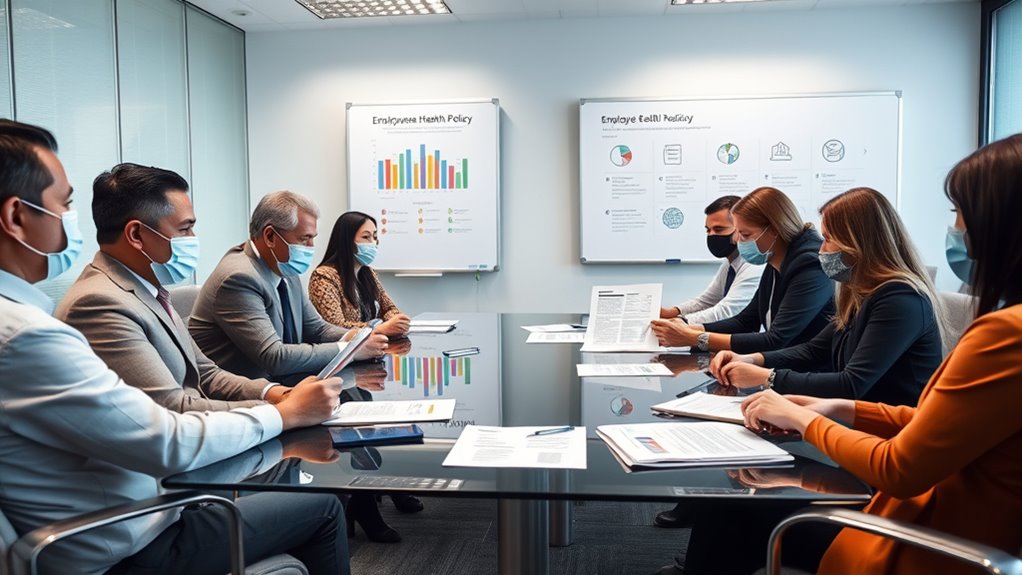To handle sick workers effectively, establish clear sick leave policies that outline entitlement and procedures, including requirements for doctor’s notes. Communicate these expectations openly and regularly through multiple channels. Foster a supportive culture by encouraging honest dialogue and providing wellness resources. Implement safety measures like PPE, proper hygiene practices, and routine cleaning. Regularly monitor employee feedback and adjust policies as needed to guarantee a safe and healthy workplace. Keep exploring to discover more tips.
Key Takeaways
- Clearly communicate sick leave policies, including eligibility, documentation requirements, and procedures for reporting illness.
- Encourage employees to stay home when sick and provide flexible options like remote work or flexible hours.
- Ensure proper hygiene protocols and PPE use to prevent infection spread among staff.
- Regularly train staff on health policies and hygiene practices, reinforcing safety measures.
- Collect employee feedback on health policies and adjust procedures to improve safety and support.
Establishing Clear Sick Leave Policies

To guarantee employees know their rights and responsibilities, establishing clear sick leave policies is essential. You should define how many sick days employees are entitled to each year and the process for requesting leave. Make sure your policy specifies whether employees need a doctor’s note for absences beyond a certain duration. Communicate any limitations or conditions, such as using sick leave only for illness or injury. Clarify whether employees can carry over unused sick days and how they should report their absence promptly. Having straightforward policies helps prevent misunderstandings and ensures fair treatment. Regularly review and update these policies to reflect legal requirements and organizational changes, so your team always knows what to expect when they need time off due to health issues. Incorporating clear communication about the benefits of sick leave policies can also improve employee trust and compliance.
Communicating Expectations Clearly to Employees

How can you guarantee employees understand your company’s expectations clearly? Start by communicating expectations directly and consistently. Use simple language and be specific about sick leave procedures, reporting protocols, and any consequences for misuse. Provide written guidelines, such as employee handbooks or policy memos, and review them during onboarding or team meetings. Encourage open dialogue by inviting questions and clarifying doubts. Make sure managers reinforce these expectations regularly and model the behavior you want. Utilize multiple channels—emails, digital platforms, or face-to-face discussions—to ensure everyone receives the message. Regularly update policies and inform employees of any changes. Clear, transparent communication builds trust and helps prevent misunderstandings, ensuring everyone knows their responsibilities when it comes to sick leave and health protocols. Additionally, consistent messaging about employee responsibilities promotes a shared understanding of policy expectations.
Promoting a Culture of Health and Support

Creating a supportive culture starts with encouraging open communication so employees feel comfortable sharing their health needs. Providing accessible wellness resources shows your commitment to their well-being. Together, these steps build an environment where health and support are truly prioritized. Embracing employee health policies can further reinforce this commitment by establishing clear guidelines and support systems.
Encouraging Open Communication
Why should open communication be a cornerstone of your employee health policies? Because it creates a trusting environment where employees feel safe sharing their concerns about health issues without fear of judgment or reprisal. When you encourage honest dialogue, you gain valuable insights into your team’s needs and challenges, enabling you to address problems proactively. Open communication also helps dispel stigma around illness, making workers more comfortable seeking help early. It fosters collaboration among management and staff, promoting transparency and mutual respect. By establishing clear channels for feedback and discussion, you empower employees to voice concerns and ask questions. Additionally, understanding the importance of home security systems can inform how organizations protect sensitive health data and ensure safety measures are in place. Ultimately, this openness cultivates a supportive workplace culture where health and well-being are prioritized, leading to improved morale and productivity.
Providing Wellness Resources
Providing accessible wellness resources demonstrates your commitment to fostering a healthy and supportive work environment. When employees have access to tools that promote well-being, they feel valued and cared for. You can offer various resources to address different needs. – On-site fitness classes or gym memberships encourage physical activity. – Mental health support, like counseling services or stress management workshops, helps employees cope better. – Nutritional guidance or healthy snacks promote good eating habits. – Educational materials on topics like sleep hygiene or work-life balance empower employees to make informed choices. Incorporating evidence-based wellness strategies can further enhance overall employee health and productivity.
Implementing Flexible Work Arrangements

Implementing flexible work arrangements can considerably boost employee well-being and productivity. By allowing your employees to choose their work hours or locations, you give them greater control over their routines, reducing stress and burnout. Flexible schedules help employees manage personal responsibilities, such as caring for sick family members or attending medical appointments, without sacrificing work quality. This flexibility encourages a healthier work-life balance, leading to increased motivation and engagement. When employees feel trusted to manage their time, they often become more committed and efficient. To implement this effectively, establish clear policies, set expectations, and provide the necessary tools for remote or flexible work. Doing so creates a supportive environment that promotes health, reduces absenteeism, and enhances overall organizational performance. Additionally, understanding the different types of paint sprayers and their proper use can improve project outcomes and efficiency.
Ensuring Proper Hygiene and Safety Measures

You should prioritize promoting hand hygiene practices, like encouraging regular handwashing and providing sanitizer stations. Make sure your team has access to personal protective equipment to stay safe in all work areas. Additionally, enforce cleaning protocols to maintain a hygienic environment and reduce health risks. Implementing grocery savings strategies can also support overall well-being by reducing stress related to expenses.
Promoting Hand Hygiene Practices
Promoting hand hygiene practices is essential for maintaining a safe and healthy work environment. When you encourage regular handwashing, you reduce the spread of germs and protect both yourself and your coworkers. Make sure handwashing stations are well-stocked with soap and clean towels. Remind everyone to wash their hands thoroughly for at least 20 seconds, especially after touching common surfaces. Use signage to reinforce proper techniques and timings. Incorporate hand sanitizer stations in high-traffic areas for quick disinfection when soap isn’t available. Foster a culture where hygiene is a priority, and employees feel responsible for maintaining cleanliness. Additionally, educating staff about the benefits of antimicrobial properties of certain hand hygiene products can further enhance compliance. These simple steps markedly lower the risk of illness and help create a safer, healthier workplace for everyone.
Providing Personal Protective Equipment
Why is providing the right personal protective equipment (PPE) vital for workplace safety? PPE acts as a crucial barrier between employees and potential hazards, reducing the risk of infection and injury. When you supply appropriate gear—such as masks, gloves, and face shields—you help prevent the spread of germs, especially when workers are sick or dealing with contaminated materials. Proper PPE also protects employees from physical hazards like chemical splashes or sharp objects. Ensuring everyone wears the right equipment fosters a safer environment and demonstrates your commitment to health standards. Remember, PPE should be correctly fitted and regularly maintained. Additionally, incorporating security measures like surveillance cameras can enhance workplace safety and monitor compliance. By prioritizing PPE, you create a safer workplace where employees feel protected and valued, which ultimately supports overall health and productivity.
Implementing Cleaning Protocols
Providing the right PPE is essential, but it’s only part of maintaining a safe workplace. Implementing cleaning protocols guarantees hygiene and reduces illness spread. You should establish a routine schedule for disinfecting high-touch surfaces like doorknobs, desks, and shared equipment. Use EPA-approved cleaning agents effective against viruses and bacteria. Train staff on proper cleaning techniques to avoid cross-contamination. Encourage employees to sanitize their hands frequently and provide accessible hand sanitizers throughout the workspace. Regularly assess cleaning practices to identify areas needing improvement. Maintain clear records of cleaning activities to ensure compliance. Incorporating best cleaning practices helps ensure thorough sanitation and minimizes health risks. By prioritizing these measures, you create a safer environment that helps prevent outbreaks and supports employee well-being.
Monitoring and Adjusting Policies Based on Feedback

To guarantee your health policies remain effective and relevant, actively monitoring feedback from employees is essential. Encourage open communication by regularly asking for their input on current protocols. Pay attention to concerns about safety, comfort, and practicality, and take note of recurring issues. Use surveys, suggestion boxes, or informal check-ins to gather insights. Once you have feedback, analyze it carefully to identify patterns or areas needing improvement. Adjust your policies accordingly, ensuring they address employees’ needs and concerns. Communicate any changes clearly and promptly, emphasizing that their input shapes the policies. This ongoing process demonstrates your commitment to a healthy, safe workplace and helps maintain trust, compliance, and morale among your team.
Frequently Asked Questions
How Do We Handle Employees Returning After Prolonged Illness?
When managing employees returning after a prolonged illness, you should prioritize open communication and flexibility. Discuss their current health status and any accommodations needed to support their reintegration back to work. Make certain they’re medically cleared and gradually reintegrated into their duties. Keep an eye on their well-being and provide ongoing support. By doing so, you foster a supportive environment that promotes recovery and productivity while safeguarding everyone’s health.
What Are Legal Considerations for Sick Leave Documentation?
When managing sick leave documentation, you need to guarantee compliance with legal requirements. You should request only necessary medical information, respect employee privacy, and keep records confidential. It’s important to follow the Family and Medical Leave Act (FMLA) and other relevant laws, which specify what documentation is required. Clear policies help prevent discrimination and legal issues, so communicate expectations transparently and document all interactions accurately.
How Can We Support Employees With Chronic Health Conditions?
Imagine your workplace as a garden, where each employee is a unique flower. To support those with chronic health conditions, you nurture their growth with understanding and flexible policies. Offer accommodations like adjustable schedules or remote work options, and promote open communication. By providing consistent care and respect, you guarantee all employees thrive, creating a vibrant, resilient garden where everyone feels valued and supported in their journey.
What Incentives Encourage Employees to Stay Home When Sick?
You want to encourage employees to stay home when sick, which benefits everyone’s health. Offering paid sick leave, flexible work options, and clear communication about the importance of rest can motivate staff to prioritize their recovery. Recognizing and rewarding responsible health choices fosters a culture of safety. When employees feel supported and understand that their well-being is valued, they’re more likely to stay home without fear of repercussions.
How Do We Address Potential Stigma Around Taking Sick Leave?
You can address stigma by normalizing sick leave, encouraging open conversations, and promoting understanding. Make it clear that taking time off when sick isn’t a sign of weakness but a step toward recovery and overall well-being. Lead by example, recognize and praise employees who prioritize health, and ensure policies support sick leave without repercussions. Creating a culture of empathy, transparency, and support helps everyone feel comfortable taking necessary time off.
Conclusion
By establishing clear sick leave policies and fostering a supportive environment, you can protect both your team and your business. Did you know that workplaces with strong health policies see a 25% reduction in sick days? When you communicate expectations and promote safety, you create a healthier, more productive workplace. Stay flexible, listen to feedback, and continually improve your policies—your employees’ well-being and your company’s success depend on it.









